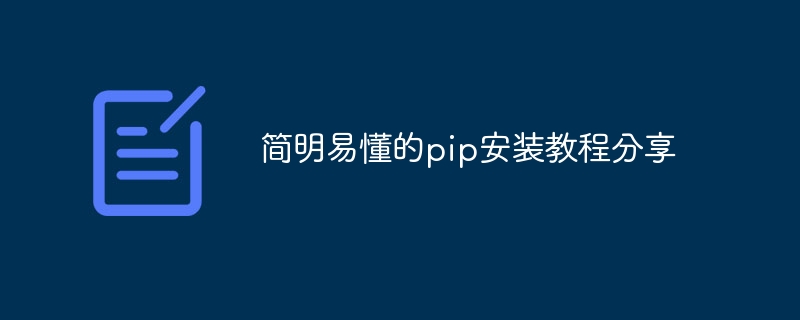Home >Backend Development >Python Tutorial >Share how to install pip easily
Share how to install pip easily
- 王林Original
- 2024-01-27 09:51:062865browse

Concise and easy-to-understand pip installation tutorial sharing
Pip is a Python package management tool that can easily install, upgrade and manage Python packages. For beginners, it is very important to learn to use pip. This article will share with you a concise and easy-to-understand pip installation tutorial to help you get started quickly.
1. Install pip
-
Check whether pip has been installed
Enter the following command in the terminal or command line to check whether pip has been installed:pip --version
If it is installed, the version number of pip will be displayed; if it is not installed, an error message will be displayed.
- Install pip
If pip is not installed, you can follow the steps below to install it: - Get the get-pip.py file on the official website: https://bootstrap.pypa. io/get-pip.py
- Download the get-pip.py file to the local directory.
-
In the terminal or command line, switch to the directory where get-pip.py is located and enter the following command to install:
python get-pip.py
-
Verify that pip is installed Success
Enter the following command in the terminal or command line to check the version of pip:pip --version
If the version number of pip is displayed, the installation is successful.
2. Use pip to install the Python package
-
Install the specified package
Enter the following command in the terminal or command line to install Specified Python package:pip install 包名
For example, install the numpy package:
pip install numpy
-
Install the specified version of the package
Sometimes we need to install a specific version of the package, you can This is accomplished by appending the version number after the package name:pip install 包名==版本号
For example, to install version 2.22.0 of the requests package:
pip install requests==2.22.0
-
Install the package from the requirements.txt file
Sometimes, we will save the required packages and their version numbers in a file called requirements.txt, and then install these packages through pip. This can be achieved through the following command:pip install -r requirements.txt
3. Examples of using pip
The following uses several specific examples to demonstrate the use of pip.
-
Install Django package
Enter the following command in the terminal or command line to install the Django package:pip install django
-
Install and specify the package Version
Enter the following command in the terminal or command line to install version 2.22.0 of the requests package:pip install requests==2.22.0
-
Upgrade package
Enter the following command in the terminal or command line , upgrade the specified package:pip install --upgrade 包名
For example, upgrade the numpy package:
pip install --upgrade numpy
-
Uninstall the package
Enter the following command in the terminal or command line to uninstall the specified package Package:pip uninstall 包名
For example, uninstall the numpy package:
pip uninstall numpy
Summary:
This article briefly introduces the installation and use of pip, including installing pip, Instructions for using pip to install Python packages, as well as usage examples of some common instructions. With this knowledge, I believe everyone will be able to use Python's package management tool pip more conveniently and improve development efficiency. Hope this article is helpful to everyone!
The above is the detailed content of Share how to install pip easily. For more information, please follow other related articles on the PHP Chinese website!
Related articles
See more- Several common methods to install python libraries using pip
- Word skills sharing: Detailed explanation of how to use 'tab stops'
- Practical Word skills sharing: several ways to count the word count of documents
- pip installation tensorflow tutorial
- Quickly learn pip installation and master the skills from scratch

